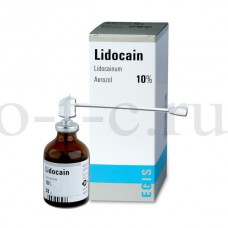Expiration date: 01/2026
Structure and Composition:
1g metered spray contains 3.8 g of lidocaine hydrochloride in aerosol containers with a metering pump, protective cap and spray 38 g, in a cardboard unit 1 aerosol can.
Pharmachologic effect:
It stabilizes the cell membrane, blocking sodium channels inhibits the formation and realization of the pain impulse.
Pharmacokinetics:
The extent of absorption of the drug is determined by the dose detecting areas of application and the degree of mucosal blood supply. After application to the mucosa of the upper respiratory tract is swallowed and partially inactivated in the gastrointestinal tract. A small part is exposed systemic absorption from a mucous membrane. Cmax is reached after 10-20 minutes. It is metabolized in the liver with the formation of two active metabolites that are excreted in the urine.
Description of the pharmacological actions:
The effect is a 1 min after application to the skin or mucous membranes and stored 5-15 minutes.
Testimony:
Local anesthesia: dental (pain point injection to local anesthesia, suturing to the mucosa, extirpation of deciduous teeth, removal of tartar), otolaryngology (surgery of the nasal septum, holding electrocoagulation, etc.), Obstetrics and gynecology (episiotomy and cut processing , removal of stitches, interventions on the vagina and cervix, and others.) with instrumental and endoscopic studies (introduction of the probe, rectoscopy, intubation, etc.), X-ray examination (eliminating nausea and gag reflex), minor surgical procedures on the skin.
Contraindications:
Hypersensitivity, sick sinus syndrome, AV block II-III degree, cardiogenic shock, liver dysfunction, myasthenia gravis, epileptiform convulsions (including history).
Application of pregnancy and breastfeeding:
Precautions (on strict conditions under the supervision of a physician).
Side effect:
From the nervous system and sensory organs: headache, dizziness, anxiety, depression, convulsions, tremors, blurred vision.
Cardio-vascular system and blood (blood, hemostasis): hypertension, bradycardia.
Allergic reactions: skin rash, pruritus, anaphylactic shock.
Other: burning sensation at the site of application (for 1 min).
Drug Interactions:
It enhances the antiarrhythmic effect of beta-blockers, the effect of muscle relaxants and sedatives. Against the background of procainamide may develop hallucinations, phenytoin (with on / in the introduction) - violation of AV conduction, MAO inhibitors - strengthening local anesthetic action.
Dosage and administration:
Locally. Before use, remove the protective cap on the rod to put on the nozzle and its end take the place of application. When you press the stop allocated 0,04-0,054 g product (4-5,4 mg of lidocaine). The dose is determined by the nature and the workpiece. Minimum dose - 1-3 doses. The number of doses: in dermatology - 1-3, dentistry and otolaryngology - 1-4 doses, endoscopic and instrumental studies - 2-3, gynecology - 4-5, obstetrics - 15-20 (maximum of 40 doses per 70 kg body weight).
The children in dental practice should preferably be used in the form of lubrication.
Overdose:
Symptoms include nausea, vomiting, pallor, agitation, tremors, clonic-tonic convulsions, collapse, depression of the central nervous system.
Treatment: symptomatic therapy.
Precautionary measures:
When applied before surgery to the pharynx or nasopharynx should be noted that as a result of the suppression of the cough reflex pharyngeal and increases the risk of pneumonia (not recommended for tonzillo- prostatectomy and children up to 8 years). Avoid contact with the respiratory tract (risk of development). In frail and elderly people should be used in minimal doses. With care apply to damaged mucosa.
Special instructions:
Children under 2 years in dental practice is recommended in the form of lubrication with a cotton swab, pre-impregnated with a solution of the drug (to avoid fright when spraying).



